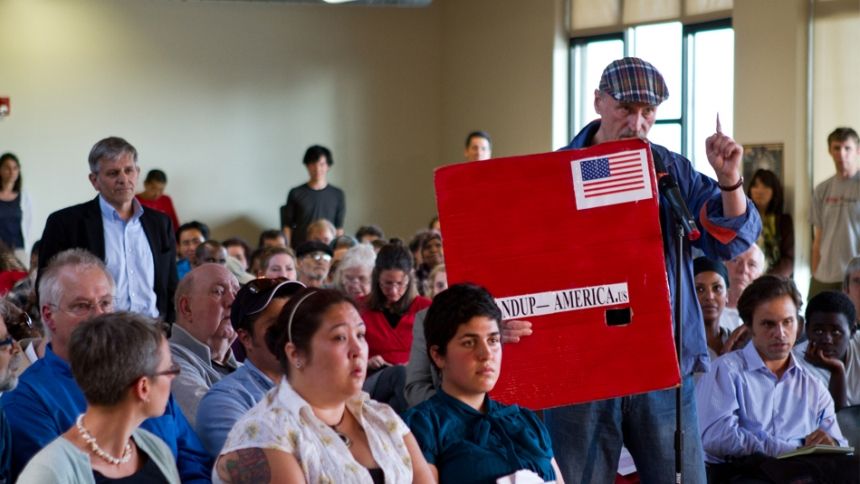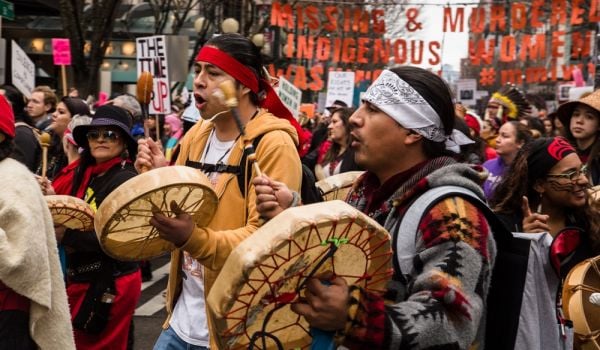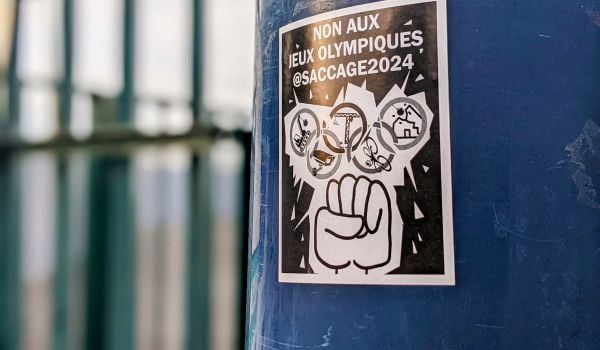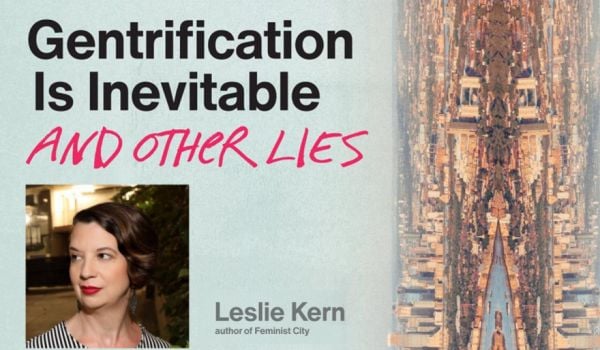The Seattle Housing Authority is rebuilding Yesler Terrace, long considered a shining example of what public housing should look like. Now approaching the redevelopment using 21st-century logic, the city has put a premium on sustainability and economic diversity. In Forefront this week, Daniel Brook examines the plans and what they mean for Yesler’s latter-day tenants, as well as the state of public housing in America.
The Seattle City Hall ought to have a banner out front reading, “Welcome to Utopia.” Visitors to the LEED Gold structure, which opened in 2003, walk right into the building — no ID check, no metal detectors, no pat-downs — as if in some pre-9/11 fantasy. As visitors gaze out the atrium’s glass curtain wall over the evergreen hills and pristine waters of the Pacific Northwest, they are invisibly enveloped in free public WiFi. If a pang of hunger strikes, the pocket-sized coffee stand hidden away near the grand staircase serves up hormone-free hard-boiled eggs and shots of the perfect espresso for which the city is famous.
The city council hearings, with their near-Scandinavian levels of decorum, order and commitment to democratic procedure, are nearly as perfect as the espresso. A veritable parody of progressive political correctness, the body is like a sketch from the HBO farce Portlandia, or an excerpt from the bestselling spoof, Stuff White People Like. Hardly the puffed-up, grandstanding big-city pols typical of America’s leading cities, Seattle’s representatives are soft-spoken and erudite. All but one — a Pacific Islander — are white.
Though atypical of America, the representatives are representative of Seattle. The prosperous city holds the title as the most educated in the nation and the distinction of being whiter than Wichita, a source of embarrassment to the city’s ubiquitous white liberals. (In Stuff White People Like, “diversity” ranks near the top of the list, beaten out by only a handful of items including “coffee” and “organic food.”)
On July 17, inside the council chamber with its swooping walls of blonde wood and brushed steel, council members were weighing far-reaching changes to one of progressive Seattle’s proudest accomplishments: The New Deal-era Yesler Terrace development, America’s first racially integrated housing project. Stroking their chins, looking overeducated and skeptical, council members pondered whether the Seattle Housing Authority’s ambitious plan to transform the low-rise, low-income public housing project into a high-rise, mixed-income, mixed-use neighborhood truly reached levels of perfection worthy of Seattle.
“Recalcitrant residents who insist on owning cars in the rebuilt neighborhood will have to hide their cars behind buildings and in underground parking lots, like so much dirty laundry.”
A model of transit-oriented sustainable urbanism, plans for the rebuilt Yesler Terrace call for densifying the existing townhome community into a neighborhood that can house eight times its current population on the same 30-acre footprint in buildings up to 300 feet tall. Inspired by recent mixed-use market-rate developments in nearby Portland, Ore. and Vancouver, British Columbia — where environmental-minded zoning has encouraged building taller in the city center to preserve green space on the periphery — the preliminary mock-ups show buildings heavy on glass, surrounded by common space heavy on green. Since private developers would ultimately do the building, the neighborhood will likely end up with plenty of the simple, sleek, earth-toned Japan-dinavian architecture that is popular in the region.
Seattle’s strict Green Factor system, a LEED-like score sheet the city has created and mandated for new development in the city, will ensure that the park-heavy mock-up becomes a reality. The transit element, too, is a fait accompli, not a New Urbanist pipe dream. Construction of a new light-rail line that will link the community to downtown, making it easy for residents who work in the city center to commute car-free, is already underway. As for cycling, city traffic engineers assured the council that bike lanes will be present throughout, and emphasized that bikes will share road with cars only on downhill streets, allowing tired cyclists to take breaks as they ascend the famed First Hill on which Yesler sits. (In the early 20th century, the site earned the nickname “Profanity Hill” in homage to the expletives its gradient elicited from exhausted pedestrians.) Recalcitrant residents who insist on owning cars in the rebuilt neighborhood will have to hide them behind buildings and in underground parking lots, like so much dirty laundry.
Occupying some of the most potentially valuable land in the city, Yesler Terrace is within walking distance of City Hall itself. But just as the steep hill dividing the two sites renders the walk more arduous than it looks on the map, the social distance between the well-to-do white council members and the immigrants of color who constitute most of the project’s tenants may be even larger. For all the meticulous concern over the design of the redevelopment, there is a sense among Yesler residents and many area neighbors that the council is missing the forest for the trees. Critics see council as quite possibly well meaning but hopelessly out of touch, so concerned about the aesthetics and environmental impact of the project, they have lost sight of its social impact — and of safeguarding the public trust itself. In the Seattle Housing Authority’s plans, the 561 units of extremely low-income housing at Yesler Terrace will be rebuilt and more than 1,000 units of low- to medium-income “workforce housing” will be added. But the bulk of the development will be devoted to as many as 3,100 market-rate units.
It is hard to argue that a low-rise neighborhood of townhomes and garden plots is the highest and best use for a plot in the heart of one of America’s most economically dynamic cities. With the towers of downtown Seattle looming over one side of the development and four hospitals abutting another, there are thousands of jobs within walking, cycling and transit distance of Yesler Terrace. The environmental impact of high-income and middle-income workers commuting in from the suburbs, when they’d be perfectly happy to live on a new-and-improved First Hill, is clear.
But the crux of the deal is for the local public housing authority to divest itself of most of Yesler Terrace’s land, selling off the bulk of the project’s footprint to private developers for an estimated $145 million. The SHA insists the divestment is necessary to raise the money it needs to put Yesler residents in better housing. But critics, who pointedly note that the housing authority has never had to open its books to prove its penury, ask why would the public agency charged with building and maintaining the city’s low-income housing want to sell off its crown jewel — especially in a time and place that improbably mixes a high-end residential real estate glut (which has paralyzed the local condo market) with an affordability squeeze for Seattleites of moderate means.
The short list of real estate developers eager to get in on the deal is hardly allaying fears. Recent planning meetings have been attended by representatives of the man who owns Seattle, Microsoft co-founder-turned-real estate magnate Paul Allen, and Forest City Ratner, the famed antagonist in the most contentious community/developer fight of the last decade, the Atlantic Yards’ Battle of Brooklyn. That fight pitted Forest City — a company known for building publicly subsidized developments — against community advocates who said its multibillion plan for a basketball stadium surrounded by a new mixed-income neighborhood of high-rise towers would displace lower-income people.
Lori Mason Curran, spokesperson for Paul Allen’s real estate arm, Vulcan, Inc., refused to discuss Yesler Terrace in even the broadest strokes. But regardless the company’s ultimate role in Yesler, Vulcan and the Seattle Housing Authority are already business partners of a sort; in its divestment fervor, the SHA recently sold off its own headquarters and now rents its offices from Vulcan.
For all the local quirks that make the Yesler redevelopment a uniquely Seattle project, it is in equal parts a federal project shaped by the Obama administration. The neighborhood is one of five to receive funds from the Department of Housing and Urban Development’s Choice Neighborhoods program. All five — in Boston, Chicago, New Orleans and San Francisco, in addition to Seattle — are located in what could be called “choice cities,” sought-after places to live for people who can afford their market rates and could choose to live almost anywhere. Specifically, the targeted neighborhoods are places that could all be attractive to well-off professionals — save for the presence of a major public housing project.
Cities that eagerly built public housing in the New Deal and Great Society eras, and then spent the 1970s and ’80s kicking themselves that they were now responsible for presiding over public slums, today find themselves sitting on urban gold mines. But choosing how to deal with their good fortune presents its own slew of new problems, albeit problems they once would have killed for. No city is cashing in its chips with quite as much relish and abandon as Seattle.
To read more, subscribe to Forefront. Already a subscriber? Click here to continue reading.
















